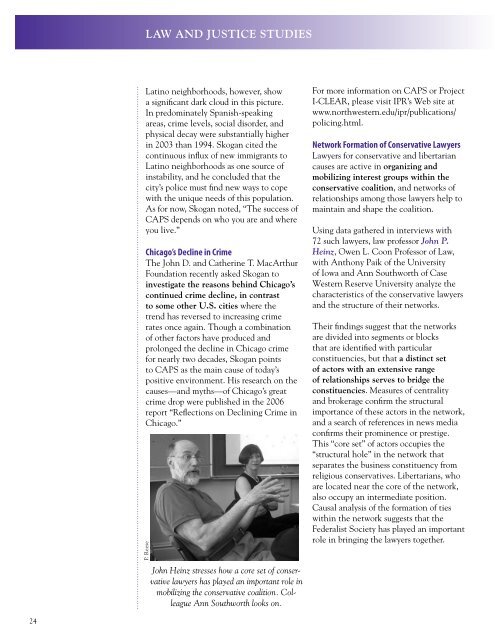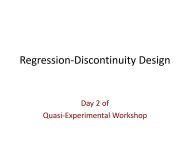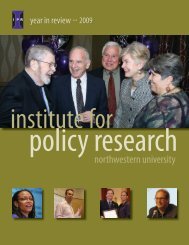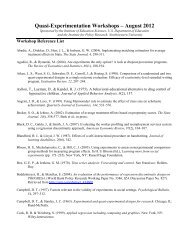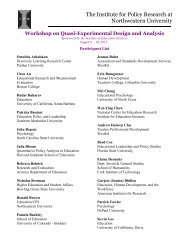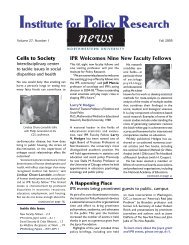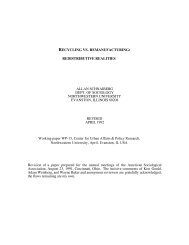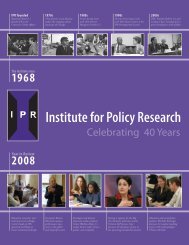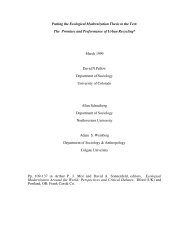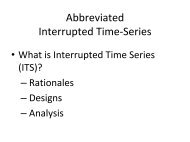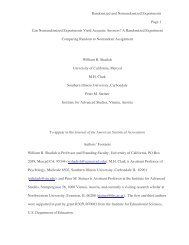pdf - Institute for Policy Research - Northwestern University
pdf - Institute for Policy Research - Northwestern University
pdf - Institute for Policy Research - Northwestern University
You also want an ePaper? Increase the reach of your titles
YUMPU automatically turns print PDFs into web optimized ePapers that Google loves.
Law and Justice Studies<br />
Latino neighborhoods, however, show<br />
a significant dark cloud in this picture.<br />
In predominately Spanish-speaking<br />
areas, crime levels, social disorder, and<br />
physical decay were substantially higher<br />
in 2003 than 1994. Skogan cited the<br />
continuous influx of new immigrants to<br />
Latino neighborhoods as one source of<br />
instability, and he concluded that the<br />
city’s police must find new ways to cope<br />
with the unique needs of this population.<br />
As <strong>for</strong> now, Skogan noted, “The success of<br />
CAPS depends on who you are and where<br />
you live.”<br />
Chicago’s Decline in Crime<br />
The John D. and Catherine T. MacArthur<br />
Foundation recently asked Skogan to<br />
investigate the reasons behind Chicago’s<br />
continued crime decline, in contrast<br />
to some other U.S. cities where the<br />
trend has reversed to increasing crime<br />
rates once again. Though a combination<br />
of other factors have produced and<br />
prolonged the decline in Chicago crime<br />
<strong>for</strong> nearly two decades, Skogan points<br />
to CAPS as the main cause of today’s<br />
positive environment. His research on the<br />
causes—and myths—of Chicago’s great<br />
crime drop were published in the 2006<br />
report “Reflections on Declining Crime in<br />
Chicago.”<br />
P. Reese<br />
John Heinz stresses how a core set of conservative<br />
lawyers has played an important role in<br />
mobilizing the conservative coalition. Colleague<br />
Ann Southworth looks on.<br />
For more in<strong>for</strong>mation on CAPS or Project<br />
I-CLEAR, please visit IPR’s Web site at<br />
www.northwestern.edu/ipr/publications/<br />
policing.html.<br />
Network Formation of Conservative Lawyers<br />
Lawyers <strong>for</strong> conservative and libertarian<br />
causes are active in organizing and<br />
mobilizing interest groups within the<br />
conservative coalition, and networks of<br />
relationships among those lawyers help to<br />
maintain and shape the coalition.<br />
Using data gathered in interviews with<br />
72 such lawyers, law professor John P.<br />
Heinz, Owen L. Coon Professor of Law,<br />
with Anthony Paik of the <strong>University</strong><br />
of Iowa and Ann Southworth of Case<br />
Western Reserve <strong>University</strong> analyze the<br />
characteristics of the conservative lawyers<br />
and the structure of their networks.<br />
Their findings suggest that the networks<br />
are divided into segments or blocks<br />
that are identified with particular<br />
constituencies, but that a distinct set<br />
of actors with an extensive range<br />
of relationships serves to bridge the<br />
constituencies. Measures of centrality<br />
and brokerage confirm the structural<br />
importance of these actors in the network,<br />
and a search of references in news media<br />
confirms their prominence or prestige.<br />
This “core set” of actors occupies the<br />
“structural hole” in the network that<br />
separates the business constituency from<br />
religious conservatives. Libertarians, who<br />
are located near the core of the network,<br />
also occupy an intermediate position.<br />
Causal analysis of the <strong>for</strong>mation of ties<br />
within the network suggests that the<br />
Federalist Society has played an important<br />
role in bringing the lawyers together.<br />
24


